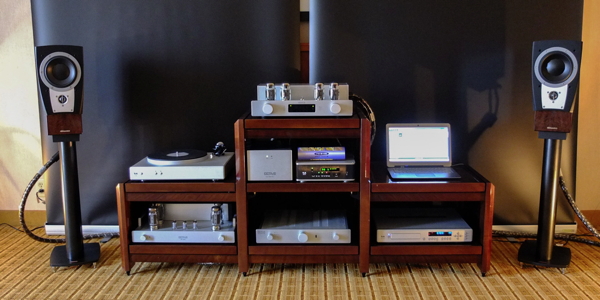
 |
|
High quality furniture products use no nails or fasteners for their wood components. Instead, a technique known as “mortise and tenon” is used for the support structure of the Kata Stand and for the Homini Stand, a technique known as “miter folding” is used on the support blocks; along with high quality glue, makes both of these designs permanent. Once a stand is completed, the final finishes are allowed to cure for a week to 10 days. Finally, they are hand-rubbed for that ultimate “feel.” Kanso then assembles every stand and lets it rest for a few days. Only then is a new Kanso Audio Stand ready for shipment. All Kanso shelves, regardless of product, are produced by laminating multiple layers of different materials chosen both for their hardness, density and anti-resonance characteristics. A special elastomeric material is used between the layers. This elastomeric material, (developed by a group of acoustic, mechanical, and chemical engineers), converts mechanical energy (vibration) into heat energy. As heat energy, it dissipates. Both the top and underside of the shelf are then clad with a solid anodized aluminum veneer of brushed black, silver, or bronze color. Copper cladding is also an option. The principal reason for the metal cladding on the surface of the shelves is for rapid transfer of vibration from the component chassis into the shelf. Because of these multiple layers of high density materials, the shelves are naturally of high mass, thereby very immune to air-borne vibrations. Attached to the bottom of the shelves are four metal cones with very sharp points. These points rest on special brackets attached to the side supports of the stand frame. In a sense, the shelves are “floating” and basically decoupled from the support structure. Sharp cones (feet) are also on the bottom of the man structural supports of the stand. The sharp points of these cones hinder floor-borne vibrations from traveling back up the structure. We also offer decoupling gliders for the feet of the support structure. These decoupling gliders allow even greater isolation from the floor but also allow you to easily swivel the rack for easy access to the cables at the rear. To give all shelves the finishing touch, the perimeter is wrapped in wood which matches the support structures of the rack. As an option, the top of the highest shelf can have a wood veneer. The underside is still clad in aluminum. The free-standing amp stands utilize the same construction techniques as the shelves. The customer has the choice of a Satin, Semi-gloss, or Gloss finish. Only water-borne lacquers are used. They are safer from a health and environmental standpoint and outperform solvent-based lacquers. The water-borne lacquer cures clearer, faster and harder than its solvent counterpart, still producing the luxurious feel that only a hand-rubbed lacquer can offer. The side structures of the Kata are constructed of solid wood. The support blocks of the Hamoni are constructed of a very dense plywood with a hand-picked veneer applied to the plywood. We apply the veneers at our facility utilizing vacuum presses for the utmost in strength and permanence. Type of wood and finish are chosen by the future owner of the audio rack. We can also match a client’s existing furniture or speakers. As a service, a graphic photo-realistic representation of any of our stand designs with the chosen wood type and finish is available upon request. For example, pictured is a 3W 2/3/2S Kata Stand matching the Mocha stained Birdseye Maple of the Dynaudio Confidence Signature Series.  |
|
|